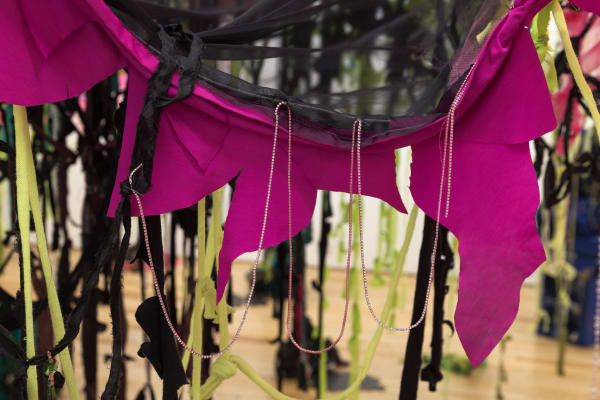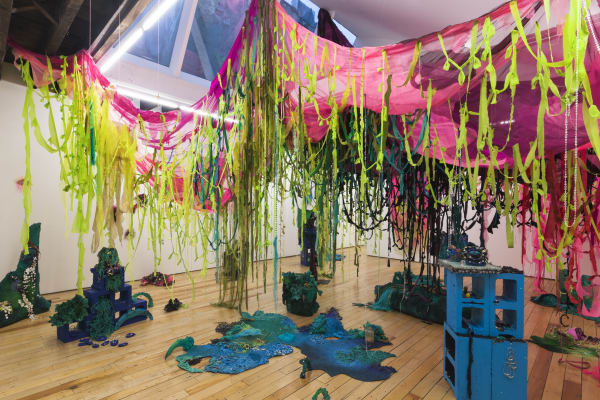MAY 24, 2023 BY JAC LAHAV
Sara Jimenez: the rain from dreams or from breaths at Rachel Uffner
Sara Jimenez’s new installation, “the rain from dreams or from breaths,” at Rachel Uffner Gallery is a thought-provoking and multi-sensory experience. Jimenez is known for examining the colonial history of the Philippines, an archipelago of over 7,000 islands in Southeast Asia that was colonized by the Spanish for almost 400 years and then by the United States for another 50 years until after World War 2.
Inspired by the artist’s recent research into ancient maritime trade routes and celestial navigation in the Philippines, this installation at Rachel Uffner features a pink and magenta textile canopy, adorned with hanging beads, buttons, and sequins, hovering over curved island-like terrains made from used astroturf.
“Sara’s practice has always inspired me. The way she is able to translate her research and interests into really beautiful and atmospheric experiences for the viewer. This show is like nothing else we have ever shown at the gallery, it’s rare to work with an artist who considers every aspect of the space in this way.” says senior director Rebekah Chozick.
Jimenez’s show is a great example of her ability to transform a white wall exhibition space. Green and blue figurative sculptural vessels align with the shape and dimensions of Jimenez’s body parts, while two-dimensional paper and fabric works on the walls reference constellations used for celestial navigation. Overall, “the rain from dreams or from breaths” is a captivating exploration of memory, kinship, and human/nonhuman relationships, skillfully woven together in a visually stunning and conceptually rich installation.
I had the pleasure of sitting down with Sara to dig a little deeper into her thoughts on ancient navigation, motherhood, and underwater shipwrecks.
On view at Rachel Uffner Upstairs Gallery May 6 – June 17, 2023
Jac Lahav: What inspired you to explore the ancient maritime trade routes and celestial navigation of the Philippines in this installation at Rachel Uffner Gallery?
Sara Jimenez: I wanted to go back further into the history of the Philippines. During my research, I came across articles about the Tabon Caves, ancient caves in Palawan that are also burial sites. These caves contain bowls, jewelry, and artifacts that represent animist belief systems, oceanic voyages to afterlives, as well as influences from Hinduism and Buddhism. These artifacts evidence ancient Austroeasian maritime trade routes in Southeast Asia and the Pacific, thousands of years before Europeans came.
JL: What navigational methods did they use back then?
SJ: I found out that navigation between islands and other countries was possible through memorization of constellations, measuring the distance of stars with one’s hand, while also following winds and ocean currents. There are more detailed systems which vary depending on the time period and culture, but generally speaking it was this kind of pre-colonial expansion, movement, and one’s direct bodily relationship to the sky, sea, and land (as opposed to through electronic devices like today) planted the seeds for this project.
JL: You mention in the press release that you use pre-owned materials and objects in your work. Can you talk about your process of collecting and repurposing these materials?
SJ: Most of the work in the exhibition is made up of second hand materials. For example, some pieces are made from familial objects, such as traditional piña fabric and fragments of furniture from my childhood home. Other materials are things that I have accumulated in my storage or studio for many years. A large chunk of the materials are from Materials for the Arts, a creative reuse center.
JL: Can you tell us more about how your family ties inform these materials?
SJ: I drew inspiration from my father, who moved to the US from the Philippines when he was nine, and would repeatedly find new uses for objects. Newspaper coverings became lunch bags, yogurt containers became Tupperware, furniture was reupholstered with old curtains, “new” bikes were sourced from the neighbors’ trash. I have been inspired by this kind of recycling system-making the most out of the things that are around.
JL: We’ve spoken before about motherhood and being an artist. It’s such a loaded topic and should be a whole other interview! But I’m curious how being a mother to a toddler has informed this current body of work?
SJ: We should definitely write a book about parenthood and making art (lol)! Red (my daughter) constantly inspires me by just being the way she is. As a 2-year old, she has no concept of gender, no fixed identity constructs, and does not have self-doubt or self-consciousness when it comes to moving in the world. She is motivated by pleasure, joy, and curiosity and is constantly expressing herself however she pleases, whenever she pleases. She didn’t wait to learn how to walk before starting to try to walk. She just kept stumbling and falling and getting up again without hesitation until one day she could walk. So I am incredibly inspired by her mental and spiritual freedom. I do feel like this kind of playful, curious energy was a core engine in the sculptures I made for this exhibition.
JL: Your work often explores themes related to memory, loss, and personal history. Are these themes continued in this current work?
SJ: The work in this show definitely relates to memory and personal history. But I would say the idea of loss is different. It is not about loss in the sense of an absence, but rather about transformation and shape shifting. I see this installation as an intersection of my body with reimagined ancient coastal caves from Southeast Asia. I see it as a sacred, boundless space, where sky, water, and land undulate and connect, where ecosystems and bodies regenerate infinitely, and where passageways are carved to afterlives.
JL: I definitely get that underwater vibe.
SJ: Yeah, transformation underwater and the uncontainable nature of the sea totally inspire me. I have a memory of snorkeling in the Philippines and seeing Japanese shipwrecks from WW2 covered in coral and fish. Similarly, I wanted these sculptural objects to materially hold the temporal quality of accumulation and unexpected physicality. In this way, the works are about ancestry not only inside my own body but in the landscape as well.
JL: What would you hope viewers take away from this exhibition?
SJ: I hope that viewers experience time travel, a kind of teleportation into another world. I hope that they feel a visceral curiosity and perhaps attraction of zooming in and out of the large and micro worlds I have created. I hope they leave with questions about their own bodies, ancestries, and their relationship to land.
About the artist: Sara Jimenez is a Filipinx-Canadian artist whose work explores the material embodiment of deep transcultural memories. Selected exhibitions include Morgan Lehman Gallery, Rachel Uffner Gallery, El Museo del Barrio, BRIC Gallery, Cornell University, The Brooklyn Museum, The Bronx Museum, and Smack Mellon, among others.





